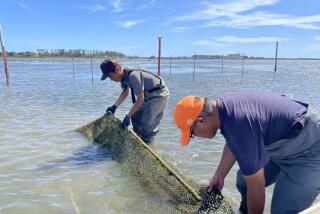Atchoo! : For Japanese, Hay Fever Season Is a Time to Be Miserable
- Share via
TOKYO — To its distinct seasons of spring, summer, fall, winter and the June rains, Japan has added a sixth--hay fever season--and it’s in full bloom.
Hay fever has become an annual, multimillion-dollar event in Japan, complete with daily television “pollen forecasts” and special surgical masks for the 20 million Japanese who sneeze their way through February, March, April and May.
Behind the kafunsho --literally, “flower powder symptoms”--phenomena are the cedar forests, planted for timber around Tokyo and other cities after World War II.
There was no problem at first, but roughly 20 to 25 years after the trees were planted, they began producing ever-larger amounts of orange, powdery pollen.
In the meantime, Japan switched to imported timber for housing, so it doesn’t need to log the trees.
Combined with the chemicals in urban smog, the pollen is causing severe allergic reactions in many Japanese.
The symptoms are the same in Japan as anywhere else--a nonstop runny nose, itchy eyes and throat, a creepy-crawly sensation in the nose, and nonstop sneezing.
To avoid inhaling the irritating stuff, most hay fever victims don white surgical masks.
One group of 11 hay fever sufferers got so fed up recently that they filed a suit against the national government, claiming $510,000 in damages.
“Hay fever is horrible. It disrupts our daily lives,” said Shigejiro Sugiyama, a 39-year-old lawyer who organized the lawsuit.
“Sometimes it’s so bad I can’t sleep and can’t even open my eyes,” said Sugiyama, who lives in Shizuoka, 94 miles west of Tokyo.
Sugiyama, whose name coincidentally translates as “cedar mountain,” blames the government for not pruning or thinning out the most pollen-laden trees--and for planting them in the first place.
At the Ministry of Agriculture, Forestry and Fisheries, officials said they had asked local governments and forest administrators to do what they can to eliminate the pollen problem.
“We do what we can to thin and trim the trees, but the labor shortage is a very big problem. Most of the forest workers are old men,” said Tetsuo Nishimura of the Agriculture Ministry’s Forest Research Institute.
With ecologists pressuring Japan to reduce its huge imports of tropical timber, the country may again resort to logging cedar for housing construction.
In the meantime, hay fever sufferers rely on antihistamine pills and sprays, eye drops and washes, pollen-proof goggles and other gadgets to minimize their misery.
The annual market for such products is more than $85 million, according to the Nikkei economic newspaper.
More to Read
Sign up for Essential California
The most important California stories and recommendations in your inbox every morning.
You may occasionally receive promotional content from the Los Angeles Times.













